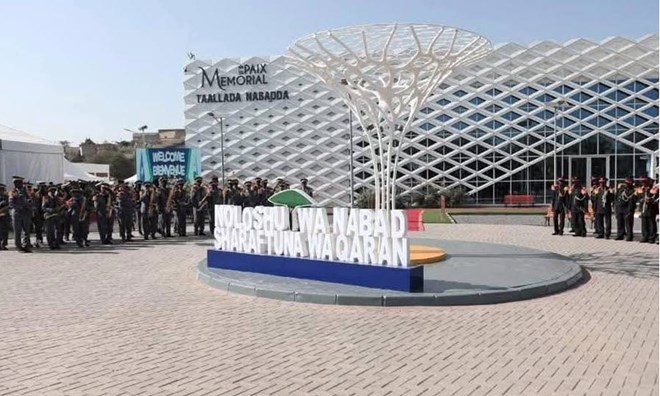Copyright hiiraan

Hiiraan Online Today from Hiiraan Online: Somali Music advertisements A Nation’s Rebirth: Reminiscing the Historic Somalia Peace Conference in Arta FacebookFacebook messengerTwitterWhatsAppLinkedInTelegramEmail Wednesday November 5, 2025 By Deqa Abdullahi Moalim Twenty-five years ago, the Somalia Peace Conference began in Arta, a town in southeastern Djibouti. It came after almost a decade of civil war, state collapse, and lawlessness. I was a teenage girl in Mogadishu at the time, and my memories of my country were all about prolonged civil war, inter-clan conflicts and destruction. The elders in the neighborhood would often reminisce about waagii nabadda, (the old days of peace). As such, the conference, which was aired live by Djibouti’s state-run TV, Radio Television of Djibouti (RTD), reignited hope in many that clan conflict would soon end and that a new era of peace would be ushered in. Our home was among the few in the neighborhood that had a TV, and when the program was about to start, many of our neighbours would join us to watch. I recall the conference coverage beginning with a promo video with a voiceover of songs from the Deegaan band. The lyrics were very touching. The video clips showing severely malnourished children, destroyed roads, and buildings delivered a clear message to Somalis that the consequence of civil war is destruction. Everyone was glued to the screen and watching the program with enthusiasm. We saw men who were once part of inter-clan conflicts now sharing a table, discussing how to end the civil war. The elders in the neighborhood were particularly ecstatic. Some of them already pictured the return of Mogadishu nightlife. I have heard a lot about it from my parents. In my head, I would piece together their stories and imagine myself in that atmosphere, walking the streets of Mogadishu at night with my family, probably drinking juice with my siblings at the shores of Lido beach on the weekends. The program would end on a note of hope and happiness – that peace and the rule of law will be restored. Some of the elders were military veterans; they would proudly talk about their ranks and hoped to soon take their uniforms out of the drawers, dust them off, and wear them again. The women, on their part, were fascinated by the First Lady of Djibouti, Madam Khadra Mahamoud Haid. They saw her as the driving force behind the peace conference. Dressed in a dirac, garbasaar and malqabad, she was majestic and commanding. RTD filled the intervals between discussions with music, poetry, and lighthearted comedy – keeping spirits high and the sense of unity alive. Commemoration and reflection When I was invited to attend the Arta Peace Memorial to commemorate the 25th anniversary of the Somali Peace Conference in Arta, I found myself deeply emotional and honoured. Actually, I have been to Arta on other occasions, but this time was different. It is in Arta where the first blocks of stability were laid. I am no longer a teenage girl unaware of what is going on around her; I am now a professional who has participated in various conferences on Somalia’s reconciliation and post-conflict reconstruction. I have travelled widely and have seen what peace means, what development means, and how far Somalia can go if peace prevails. On Thursday morning, the 30th of October 2025, after breakfast, a bus picked us up from our hotels in Djibouti city to attend the memorial ceremony in Arta. A significant number of the delegates were participants of the Somalia Peace Conference, most of them in their late 60s, 70s or 80s. Although they looked frail, you could tell they were excited to be in Arta again – the city where they planted the seeds of hope that Somalis would reconcile and peace would be restored. The background song, Soomaaliyeey Toos Toos (Oh Somalis, wake up) was so moving and enchanting. Amid the celebratory scenes and the music performances, I remembered my father. He was among the Arta delegates in 2000. Age and health issues have caught up with him, and he was not in a better position to attend the 25th-anniversary event. Back then, following his return to Mogadishu, just days before the presidential election due to his planned overseas trip, many family members and friends visited him to hear about Arta and the discussions that he had witnessed. Technology was not advanced then, and BBC Somali and local radio news like Horn Afrik were the main sources of news. So to have him narrate first-hand information was something the neighborhood eagerly anticipated. As I stood under the tent and as I walked into the newly built memorial centre, I felt my father’s presence. I imagined him engaging in shuttle diplomacy, discussing with fellow delegates, accepting some proposals, and rejecting others. I imagined women delegates at the time voicing the plight of women and children affected by the civil war and calling for inclusion in decision-making. I imagined how tough it must have been for the mediators led by the president of Djibouti, Ismail Omar Guelleh, to convince extremely polarized sides to engage in talks. Election Night When my dad returned to Mogadishu after the 2000 Arta conference, I remember his friends and neighbors asking him who he thought was among the top candidates for the presidential race, and he would say “ Ina salaad booy”, referring to Abdiqasim Salad Hassan. On election night, our home was crowded as if it were a big football match. My dad’s prediction was spot-on – Abdiqasim Salad Hassan was elected president. He was favored by many. Those watching believed their dreams were finally coming true – Somalia would have peace, and its people would be united. As people went to sleep, they were already preparing to welcome the newly elected president. For Somalis, President Guelleh was their hero. People painted cross-flag pins for Djibouti and Somalia on walls, front doors, and flower pots to symbolise fraternity and shared identity. Songs about national unity have now become the hit songs of the year. We would go to small studios and ask them to record popular songs on audio cassette tapes, such as Soomaaliyey Toos Toos, Buur Awliyaad, and Daya Afrika Daya, Safar baa la tagaya, Dib baa loo noqonayaa, and Kursigaas baan cashaqayeey, among others. A Nation’s Rebirth One morning, during the assembly, we were told that the Somali president was coming to the Mogadishu stadium. We were loaded into buses and taken there. Other school children in neat uniforms also joined us. Our teachers were guiding us to the main gates. There was a sense of jubilation everywhere. After the fall of Mohamed Siad Barre regime, the stadium had become a no-go area. The city was separated by a green line into northern and southern parts. Movement was minimal for residents. My school was located in the northern part of the city, and the stadium is in the south. But following the Arta conference and the election of the new president, movement was allowed for the first time in a decade. I had never seen such a crowd in my life. As we approached the stadium's entrance gate, we spotted a female military officer in uniform; it did not fit her properly. In fact, it is as if she had stitched together two different pairs of trousers to make one that fit, unlike her male counterparts. Uniforms were scarce due to the war, and people wore whatever they could find that resembled one. We had never seen a uniformed officer before, let alone a female one. The stadium was fully packed, and a military parade was held. We would cheer and point our fingers at them whenever we saw female officers in the parade; even though there were only a few hundred, the sight was new and exciting. As I grew older, I witnessed other presidential elections in and outside Somalia. None of them matched the Arta election’s authenticity, hope, and unity. While at the memorial, I felt proud to be there and hopeful that things would only get better for Somalia. President Guelleh captured my thoughts in his speech at the anniversary: “Soomaliyeey, shalay haddaan idin iri war ii hiiliya, maanta waxaan idin leeyahay, idinka isku hiiliya” “Oh Somalis, If I asked you yesterday to help me (by making the conference fruitful), today I ask you to help yourselves (by promoting peace and unity).” As I write this while travelling back to Somalia, I know our nation’s rebirth is still unfinished. Yet, I remain hopeful that we can work on Arta’s legacy, strengthen our unity, and finally become a peaceful and prosperous nation. To what extent have the hopes for peace and unity, felt during and after the Arta conference, been realized? Have the dreams of the elders, women, and youth at the Arta peace conference come to fruition? What tangible progress has Somalia made since the Arta Conference in terms of stability, governance, and state-building?. In the forthcoming article, I look forward to sharing with you whether those aspirations and expectations have been fulfilled over the past 25 years since the Arta Conference. The author of the article, Deqa Abdullahi Moalim, can be reached at [email protected]. Opinion| Privacy Policy|Sports|Somali Music|Somali Map All Rights Reserved Copyright. © 1999-2025, www.hiiraan.com



